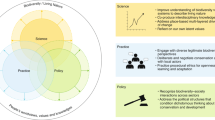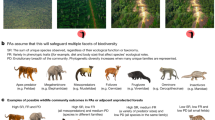Abstract
Global biodiversity loss is indicative of the massive influence of human activity that defines the Anthropocene. Some scholars argue that changes in behaviour at the scale necessary to address this crisis will require wholesale change in cultural values. However, evidence is lacking on whether values are shifting. To better understand this phenomenon, we analysed long-term, large-scale trend data regarding wildlife values in the United States, collected through a 19-state survey in 2004 (n = 12,673) and 2017–2018 (n = 20,674). Findings confirmed an increased endorsement of mutualism values (seeing wildlife as part of one’s social community and deserving of rights like humans) accompanied by a decline in values emphasizing domination (treating wildlife as resources to be used for human benefit), a trend further visible in cross-generational cohort analysis. We also found strong associations between state-level values and trends in urbanization, connecting the shift to macro-level socioeconomic factors. Results suggest positive outcomes for conservation but the field’s ability to adapt will be critical to realizing those outcomes.
This is a preview of subscription content, access via your institution
Access options
Access Nature and 54 other Nature Portfolio journals
Get Nature+, our best-value online-access subscription
$29.99 / 30 days
cancel any time
Subscribe to this journal
Receive 12 digital issues and online access to articles
$119.00 per year
only $9.92 per issue
Buy this article
- Purchase on Springer Link
- Instant access to full article PDF
Prices may be subject to local taxes which are calculated during checkout




Similar content being viewed by others
Data availability
The data that support the findings of this study are available from the corresponding author upon reasonable request.
Change history
16 December 2020
A Correction to this paper has been published: https://doi.org/10.1038/s41893-020-00675-2
References
Bell, D. The coming of the post-industrial society. Educ. Forum 40, 574–579 (1976).
Veenhoven, R. Life is getting better: societal evolution and fit with human nature. Soc. Indic. Res. 97, 105–122 (2010).
Díaz, S. et al. Pervasive human-driven decline of life on Earth points to the need for transformative change. Science 366, eaax3100 (2019).
Ripple, W. J. et al. World scientists’ warning to humanity: a second notice. BioScience 67, 1026–1028 (2017).
Pimm, S. L. et al. The biodiversity of species and their rates of extinction, distribution, and protection. Science 344, 1246752 (2014).
Ceballos, G. et al. Accelerated modern human-induced species losses: entering the sixth mass extinction. Sci. Adv. 1, e1400253 (2015).
Ehrlich, P. R. & Kennedy, D. Millennium assessment of human behavior. Science 309, 562–563 (2005).
Crompton, T. Common Cause: The Case for Working with Our Cultural Values (World Wildlife Fund, 2010).
What is the Great Transition? Great Transition Initiative https://greattransition.org/about/what-is-the-great-transition (2020).
Wilson, D. S. Intentional cultural change. Curr. Opin. Psychol. 8, 190–193 (2016).
Gelfand, M. J. et al. Differences between tight and loose cultures: a 33-nation study. Science 332, 1100–1104 (2011).
Oishi, S. & Graham, J. Social ecology: lost and found in psychological science. Perspect. Psychol. Sci. 5, 356–377 (2010).
Mace, G. M. Whose conservation? Science 345, 1558–1560 (2014).
Teel, T. L. & Manfredo, M. J. Understanding the diversity of public interests in wildlife conservation. Conserv. Biol. 24, 128–139 (2009).
Manfredo, M. J., Teel, T. L. & Dietsch, A. M. Implications of human value shift and persistence for biodiversity conservation. Conserv. Biol. 30, 287–296 (2016).
Manfredo, M. J., Berl, R. E. W., Teel, T. L., & Brusktotter, J. T. Bringing social values to wildlife conservation decisions. Front. Ecol. Environ. (in the press).
Simberloff, D. Flagships, umbrellas, and keystones: is single-species management passé in the landscape era? Biol. Conserv. 83, 247–257 (1998).
Meine, C., Soulé, M. & Noss, R. F. “A mission‐driven discipline”: the growth of conservation biology. Conserv. Biol. 20, 631–651 (2006).
Ives, C. D. & Kendal, D. The role of social values in the management of ecological systems. J. Environ. Manag. 144, 67–72 (2014).
Manfredo, M. J. et al. Why social values cannot be changed for the sake of conservation. Conserv. Biol. 31, 772–780 (2017).
Schwartz, S. H. A theory of cultural value orientations: explication and applications. Int. J. Comp. Sociol. 5, 136–182 (2006).
Bruskotter, J. T. et al. Conservationists’ moral obligations toward wildlife: values and identity promote conservation conflict. Biol. Conserv. 240, 108296 (2019).
Smolicz, J. Core values and cultural identity. Ethn. Racial Stud. 4, 75–90 (1981).
Geels, F. W. Technological transitions as evolutionary reconfiguration processes: a multi-level perspective and a case-study. Res. Policy 31, 1257–1274 (2002).
Kitayama, S., Conway, L. G. III, Pietromonaco, P. R., Park, H. & Plaut, V. C. Ethos of independence across regions in the United States: the production-adoption model of cultural change. Am. Psychol. 65, 559–574 (2010).
Inglehart, R. Culture Shift in Advanced Industrial Society (Princeton Univ. Press, 2018).
Tormos, R. The Rhythm of Modernization: How Values Change Over Time (Brill, 2019).
Bardi, A., Lee, J. A., Hofmann-Towfigh, N. & Soutar, G. The structure of intraindividual value change. J. Pers. Soc. Psychol. 97, 913–929 (2009).
Gouveia, V. V., Vione, K. C., Milfont, T. L. & Fischer, R. Patterns of value change during the life span: some evidence from a functional approach to values. Pers. Soc. Psychol. Bull. 41, 1276–1290 (2015).
Bardi, A. & Goodwin, R. The dual route to value change: individual processes and cultural moderators. J. Cross Cult. Psychol. 42, 271–287 (2011).
Hitlin, S. & Piliavin, J. A. Values: reviving a dormant concept. Annu. Rev. Sociol. 30, 359–393 (2004).
Inglehart, R. Aggregate stability and individual-level flux in mass belief systems: the level of analysis paradox. Am. Political Sci. Rev. 79, 97–116 (1985).
Molloy, R., Smith, C. L. & Wozniak, A. Internal migration in the United States. J. Econ. Perspect. 25, 173–196 (2011).
Motyl, M., Iyer, R., Oishi, S., Trawalter, S. & Nosek, B. A. How ideological migration geographically segregates groups. J. Exp. Soc. Psychol. 51, 1–14 (2014).
Kluckholn, C. in Toward a General Theory of Action (eds T. Parsons. T. & Shils, E. A.) 388–433 (Harvard Univ. Press, 1951).
Manfredo, M. J., Teel, T. L. & Henry, K. L. Linking society and environment: a multilevel model of shifting wildlife value orientations in the western United States. Soc. Sci. Quart. 90, 407–427 (2009).
Bruskotter, J. T. et al. Modernization, risk, and conservation of the world’s largest carnivores. BioScience 67, 646–655 (2017).
Manfredo, M. J., Urquiza-Haas, E. G., Carlos, A. W. D., Bruskotter, J. T. & Dietsch, A. M. How anthropomorphism is changing the social context of modern wildlife conservation. Biol. Conserv. 241, 108297 (2019).
Inglehart, R. & Welzel, C. Modernization, Cultural Change, and Democracy: The Human Development Sequence (Cambridge Univ. Press, 2005).
Jacobson, C. A. & Decker, D. J. Governance of state wildlife management: reform and revive or resist and retrench? Soc. Nat. Resour. 21, 441–448 (2008).
Cohen, J. Statistical Power Analysis for the Behavioural Sciences 2nd edn (Routledge, 1988).
Fisher, P. A political outlier: the distinct politics of the millennial generation. Society 55, 35–40 (2018).
Tormos, R., Vauclair, C. M. & Dobewall, H. Does contextual change affect basic human values? A dynamic comparative multilevel analysis across 32 European countries. J. Cross Cult. Psychol. 48, 490–510 (2017).
Schuster, C., Pinkowski, L. & Fischer, D. Intra-individual value change in adulthood: a systematic literature review of longitudinal studies assessing Schwartz’s value orientations. Z. Psychol. 227, 42–52 (2019).
Bruskotter, J. T., Vucetich, J. A. & Nelson, M. P. Animal rights and wildlife conservation: conflicting or compatible. Wildl. Prof. 11, 40–43 (2017).
Wildes, F. T. Recent themes in conservation philosophy and policy in the United States. Environ. Conserv. 22, 143–150 (1995).
Manfredo, M. J. et al. America’s Wildlife Values: The Social Context of Wildlife Management in the U.S. (Colorado State Univ., 2018).
Duffin, E. Forecast on Urbanization in the U.S., 2000-2050 (Statistica, 2019).
Oishi, S. et al. Does a major earthquake change job preferences and human values? Eur. J. Pers. 31, 258–265 (2017).
Diamond, J. Collapse: How Societies Choose to Fail or Succeed (Penguin, 2011).
Kenter, J. O. et al. Loving the mess: navigating diversity and conflict in social values for sustainability. Sustain. Sci. 14, 1439–1461 (2019).
Dillman, D. A., Smyth, J. D. & Christian L. M. Internet, Phone, Mail, and Mixed-Mode Surveys: The Tailored Design Method (John Wiley & Sons, 2014).
Scheaffer, R. L., Mendenhall, W. & Ott, L. Elementary Survey Sampling 5th edn (Duxbury, 1996).
Keeter, S. et al. What Low Response Rates Mean for Telephone Surveys (Pew Research Center, 2017).
Stedman, R. C. et al. The end of the (research) world as we know it? Understanding and coping with declining response rates to mail surveys. Soc. Nat. Resour. 32, 1139–1154 (2019).
American Community Survey 2016 5-Year Estimates (US Census Bureau, 2017).
National Survey of Fishing, Hunting, and Wildlife-Associated Recreation (US Census Bureau, 2011).
Urban and Rural (US Census Bureau, 2018); https://www.census.gov/programs-surveys/geography/guidance/geo-areas/urban-rural.html
SAGDP2S: Annual Gross Domestic Product by State (US Bureau of Economic Analysis, 2010); https://apps.bea.gov/iTable/index_regional.cfm
Kerlinger, F. N. & Lee, H. B. Foundations of Behavioral Research 4th edn (Wadsworth, 2000).
Benjamini, Y. & Hochberg, Y. Controlling the false discovery rate: a practical and powerful approach to multiple testing. J. R. Stat. Soc. B 57, 289–300 (1995).
Acknowledgements
We thank the Western and Midwest Associations of Fish and Wildlife Agencies for their sponsorship of this study, which was funded by state agency contributions and a grant awarded through the 2015 Multistate Conservation Grants Program (grant no. F15AP00726). We also thank the following individuals for their contributions to the project: A. Don Carlos, A. Dietsch, L. Sullivan, A. Bright, D. Fulton, D. Smith, L. Kruckenberg, D. VonDeBur, C. Campbell, C. Boyd, L. Cornicelli, M. Duda, A. Criscione and A. Lanier.
Author information
Authors and Affiliations
Contributions
M.J.M. wrote the manuscript with input from all of the authors. M.J.M. and T.L.T. conceptualized and designed the project, secured funding and collected the data. J.T.B. and S.K. contributed to conceptual development. R.E.W.B. conducted data analysis.
Corresponding author
Ethics declarations
Competing interests
The authors declare no competing interests.
Additional information
Peer review information Nature Sustainability thanks Sarah Bekessy, Joern Fischer and the other, anonymous, reviewer(s) for their contribution to the peer review of this work.
Publisher’s note Springer Nature remains neutral with regard to jurisdictional claims in published maps and institutional affiliations.
Supplementary information
Supplementary Information
Supplementary Figs. 1 and 2 and Tables 1–4.
Rights and permissions
About this article
Cite this article
Manfredo, M.J., Teel, T.L., Berl, R.E.W. et al. Social value shift in favour of biodiversity conservation in the United States. Nat Sustain 4, 323–330 (2021). https://doi.org/10.1038/s41893-020-00655-6
Received:
Accepted:
Published:
Issue Date:
DOI: https://doi.org/10.1038/s41893-020-00655-6
This article is cited by
-
Is Pumba still beloved? People’s perception on wild boar in Portugal
European Journal of Wildlife Research (2024)
-
The devil you know and the devil you don’t: current status and challenges of bovine tuberculosis eradication in the United States
Irish Veterinary Journal (2023)
-
Activating faith: pro-environmental responses to a Christian text on sustainability
Sustainability Science (2023)
-
Can Disparate Shared Social Values Benefit the Conservation of Biodiversity in Hong Kong’s Sacred Groves?
Human Ecology (2023)
-
Diverse values of nature for sustainability
Nature (2023)



